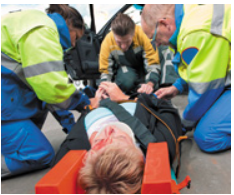
52-Year-Old Male with Multiple Sclerosis
Mr. Ayers was diagnosed with an aggressive form of multiple sclerosis 18 years ago. His illness has not responded to conventional treatments so he's been referred to your clinic for a clinical trial.
The doctor explains that his treatment will involve giving Mr. Ayers a drug that will release stem cells from his bone marrow so they can be collected from his blood. Then Mr. Ayers will be given (1) drugs that will destroy the blood-forming cells in his bone marrow, and (2), antibodies against his T lymphocytes. Finally, the stem cells that were collected from him will be used to repopulate his bone marrow.

The doctor says, “This treatment avoids problems, such as transplant rejection, that are associated with other kinds of transplants.”
4. NCLEX-STYLE You’re talking with Mr. Ayers about his course of treatment. Which of his statements indicates a need for further instruction?
a.“It's ironic that they’re giving me antibodies against my T cells, when I already attack my own tissues."
b.“I’m gonna ask the doc to not give me the stem cells after they destroy my bone marrow.
After all, the immune cells are what's hurting me!"
c.“My T cells are just brutal. Gotta get those bad boys under control!"
d.“I’m guessing the real trouble was something that happened to my T cells."
Want to see the full answer?
Check out a sample textbook solution
Chapter 21 Solutions
HUMAN ANATOMY & PHYSIOLOGY (LCPO)
- State the five functions of Globular Proteins, and give an example of a protein for each function.arrow_forwardDiagram of check cell under low power and high powerarrow_forwarda couple in which the father has the a blood type and the mother has the o blood type produce an offspring with the o blood type, how does this happen? how could two functionally O parents produce an offspring that has the a blood type?arrow_forward
- What is the opening indicated by the pointer? (leaf x.s.) stomate guard cell lenticel intercellular space none of thesearrow_forwardIdentify the indicated tissue? (stem x.s.) parenchyma collenchyma sclerenchyma ○ xylem ○ phloem none of thesearrow_forwardWhere did this structure originate from? (Salix branch root) epidermis cortex endodermis pericycle vascular cylinderarrow_forward
- Identify the indicated tissue. (Tilia stem x.s.) parenchyma collenchyma sclerenchyma xylem phloem none of thesearrow_forwardIdentify the indicated structure. (Cucurbita stem l.s.) pit lenticel stomate tendril none of thesearrow_forwardIdentify the specific cell? (Zebrina leaf peel) vessel element sieve element companion cell tracheid guard cell subsidiary cell none of thesearrow_forward
- What type of cells flank the opening on either side? (leaf x.s.) vessel elements sieve elements companion cells tracheids guard cells none of thesearrow_forwardWhat specific cell is indicated. (Cucurbita stem I.s.) vessel element sieve element O companion cell tracheid guard cell none of thesearrow_forwardWhat specific cell is indicated? (Aristolochia stem x.s.) vessel element sieve element ○ companion cell O O O O O tracheid O guard cell none of thesearrow_forward
 Human Heredity: Principles and Issues (MindTap Co...BiologyISBN:9781305251052Author:Michael CummingsPublisher:Cengage Learning
Human Heredity: Principles and Issues (MindTap Co...BiologyISBN:9781305251052Author:Michael CummingsPublisher:Cengage Learning Medical Terminology for Health Professions, Spira...Health & NutritionISBN:9781305634350Author:Ann Ehrlich, Carol L. Schroeder, Laura Ehrlich, Katrina A. SchroederPublisher:Cengage Learning
Medical Terminology for Health Professions, Spira...Health & NutritionISBN:9781305634350Author:Ann Ehrlich, Carol L. Schroeder, Laura Ehrlich, Katrina A. SchroederPublisher:Cengage Learning Biology 2eBiologyISBN:9781947172517Author:Matthew Douglas, Jung Choi, Mary Ann ClarkPublisher:OpenStax
Biology 2eBiologyISBN:9781947172517Author:Matthew Douglas, Jung Choi, Mary Ann ClarkPublisher:OpenStax Biology: The Unity and Diversity of Life (MindTap...BiologyISBN:9781305073951Author:Cecie Starr, Ralph Taggart, Christine Evers, Lisa StarrPublisher:Cengage Learning
Biology: The Unity and Diversity of Life (MindTap...BiologyISBN:9781305073951Author:Cecie Starr, Ralph Taggart, Christine Evers, Lisa StarrPublisher:Cengage Learning





